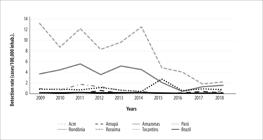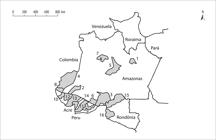Abstract
Objective:
To analyze the annual incidence of hepatitis D cases in both Brazil and the Brazilian Northern region between 2009 and 2018.
Methods:
This was an ecological study of hepatitis cases notified on the Notifiable Health Conditions Information System (SINAN), analyzed by sex, age groups, and Northern region states. Temporal trend analysis was performed using the Prais-Winsten method to estimate incident rate annual percent change (APC).
Results:
In the period studied, 2,710 cases were reported in Brazil, 74.5% of them in the Northern region and 71.5% in Amazonas, Acre and Rondonia alone. APC showed a downward trend in Brazil as a whole (-21.6% - 95%CI -3.8;-36.2%), in the Northern region (-28.5% - 95%CI -5.2;-46.1%,), in Amazonas (-34.1% - 95%CI -0.8;-56.2%) and in Acre (-37.6% - 95%CI -18.0;-52.6%). Cases decreased in age groups below 40 years old.
Conclusion:
There was a downward trend in incidence in the Western Amazon, impacting incidence in Brazil as a whole. This fall was led by younger people, probably due to hepatitis B vaccination.
Keywords:
Hepatitis D; Neglected Diseases; Time Series Studies; Epidemiological Monitoring; Incidence; Amozonian Ecosystem.

 Thumbnail
Thumbnail
 Thumbnail
Thumbnail

 Note: Municipality of residence and respective notified cases: 1. Manaus (404); 2. Eirunepé (149); 3. Lábrea (123); 4. Atalaia do Norte (100); 5. Coari (54); 6. Boca do Acre (45); 7. Fonte Boa (38); 8. Guajará (17); 9. Rio Branco (226); 10. Cruzeiro do Sul (143); 11. Sena Madureira (41); 12. Tarauacá (39); 13. Feijó (25); 14. Santa Rosa do Purus (15); 15. Porto Velho (64); and 16. Guajará-Mirim (7).
Note: Municipality of residence and respective notified cases: 1. Manaus (404); 2. Eirunepé (149); 3. Lábrea (123); 4. Atalaia do Norte (100); 5. Coari (54); 6. Boca do Acre (45); 7. Fonte Boa (38); 8. Guajará (17); 9. Rio Branco (226); 10. Cruzeiro do Sul (143); 11. Sena Madureira (41); 12. Tarauacá (39); 13. Feijó (25); 14. Santa Rosa do Purus (15); 15. Porto Velho (64); and 16. Guajará-Mirim (7).